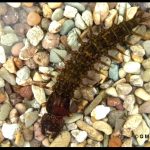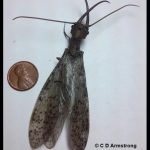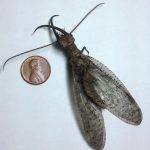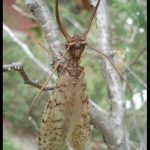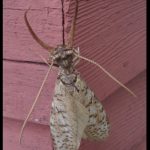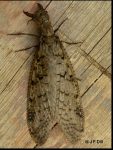Dobsonflies
Dobsonflies (genus Corydalus) are large and rather fearsome-looking insects (they raise their heads and open and close their jaws to try to intimidate, often quite successfully). They are primarily nocturnal, are more common near bodies of water, are active from late spring to mid-summer, and are attracted to lights. Both males and females can reach up to five inches in length, and although the rather frightening pincer-like mandibles of the male are much larger and more intimidating in appearance than are the female’s, they are so large that they afford weak leverage and are thus incapable of breaking a person’s skin. They are mostly ‘all show,’ so to speak, for impressing females, but also they are used for grasping a female during copulation. The mandibles (pincers) of the female, however, are short and stout and thus capable of inflicting a painful–but not venomous–bite (they are strong and sharp enough to draw blood).
-
Dobsonfly larva
(also called a Hellgrammite)
- A male dobsonfly; Orono, ME (07/17/2018).
- Ventral view of the specimen shown at left
- Male dobsonfly
- Dobsonflies (their larvae are aquatic)
- Female dobsonfly
Other features: The wings of a dobsonfly are densely lined with intersecting veins, and when the insect is at rest, the wings are folded along the length of the body, i.e. parallel to the body. Their antennae are long and have many segments. Dobsonflies possess an irritating, foul-smelling defensive anal spray that they use as a last resort. The larvae–called hellgrammites (see photo below)–are aquatic, can reach anywhere from 2″ to 3″ in length, and are familiar to fishermen who like to use them as bait, especially for catfish.
Additional Photos and Information: Dobsonflies (Texas A&M)

